-
Deacon Paul Oral History Transcription
Genevieve: The first question I have is how did you find out about St Gregory?
Deacon Paul: Well, I had been at St. Mary of the Lake for about 30 years and when Covid came things kind of quieted down and I…I’m 80 now so I had turned over 75 so I was supposed to retire, and I was bored to death, and the pastor at that time father Paul, called me and said “what are you doing?”. I said “well I’m really going crazy” but he said “would you like to come here?”. I said “I would. I would love to come there”. I had a history here too, my two adopted sons went to high school here. They are way at the top with father Paul (gestures to image in his office). They are fifty and forty eight now. So I knew the parish. Cause for the seven years (because they aren’t twins) I did the bingo games (parents had to do all that). And I played the organ every so often when the organist would have a vacation. So I knew the parish and thought “well this would be a good place”.
GS: Okay that’s really cool! We’ve read a lot about the history of the parish for the project and the school as well. So how did you feel the first time you visited the church or even the school. Just what was your first impression of the congregation?
DP: Well I really knew the organist and I’m going to give you this book when you leave *holds up parish 75th anniversary book*. I would come and play the organ for him as I said when he would go on vacations so I knew the parish that way. And then as I said my sons had gone to the high school and one of the (sons) daughters went to grammar school here and I paid her tuition so I knew the grammar school teachers, high school teachers, that’s how it worked.
Gs: Okay. Very cool! What would you say the role of this church is in the neighborhood is?
DP: Well now we don’t have a school anymore. The children, like in a lot of catholic schools, we’ve combined. And we’re part of this…this parish is really part of 3 parishes. We are part of st. Ita, St. Thomas
GS: Yes. We (the class) are working with all 3.
DP: And st Ita is where the school is.
GS: Okay, I didn’t realize that.
DP: It’s called st Thomas as caterberey school but we use that school building because it’s newer, and bigger, and has a little gym.
GS: Oh yeah that’s better for the kids. How has this church (you’ve mentioned you’ve only been with st Gregory since Covid) but what changes have you noticed besides the merger or along with the merger?
DP: While the changes are that the congregation has changed a lot. It was a very German parish when it was founded, and then Irish started coming in. So mainly German and Irish. And a lot of families, the school was huge, between the high school and the grammar school you had between six hundred and seven hundred kids going to school there. So those people have grown up, they’ve left, and the new generation coming in, a lot of gays in the neighborhood, a lot of a lesbian gals, and most of them don’t have children, so that affected the parish. But the parish still has a good number of those folks coming in, they feel welcome and included.
GS: Oh okay, that’s great!
DP: So the parish is doing very well but we only have one mass Saturday night and one mass Sunday. So all together maybe we get 150 people, whereas ten years ago we had 500 people. But this is something all of the whole country with Catholics and Lutherans, and Methodists, the church attendance is very low now.
GS: Yes, it’s very interesting we’ve touched on that in class. It’s interesting my grandmas church was featured in an article about it. I think it’s St. John of the cross in Western Springs, and it mentioned that one is doing pretty well but the attendance is still down. So other than the lower enrollment what other challenges has this parish been facing?
DO: Well, financially we are okay because we rent those schools (the building that formerly held the congregation’s elementary and high schools). The rent , it’s amazing how the rent keeps us going. So with you think of it the buildings of the schools are still used for education. And that makes us feel good, they went turned into condominiums.
GS: What would you say is unique about this parish?
DP. It’s very welcoming. It’s very open to uh, diversity of people at LGBT folks come here and feel welcome.
GS: Okay! So I feel like this history of the parish, it was first mostly German speakers, and then more Irish families . What are the demographics like now?
DP: Oh my the League of Nations! It’s really the League of Nations. Now this site, at Gregory is all together different from St. Ita in the sense that St. Ita has people from every continent of the world.
GS: Oh okay.
DP: If you were to go to mass there on Sunday, there’s all kinds of people from Africa, Asia, Ukraine. Here there are some black (people), but no Spanish (speakers), they go to St. Ita because that’s where Spanish mass is. Now the neighborhood there’s no (not many) Spanish (speakers) that can afford to live around here.
GS: Yes, it’s a pretty white neighborhood.
DP: A lot of Filipinos. The biggest makeup of an ethnic group is Filipino.
GS: How do you feel about the label.. this is kind of considered to be the biggest art and cultural center of the three churches of the mary mother of god merger. How do you feel about that?
DP: Well it’s always had a history of good music and uh then there was Joseph Melham, the iconographer who spent like 20 years here, and up in the third floor he had a studio. So he would have icon workshops for the parishioners. They always had good music, concerts, so it’s the cultural end of the three parishes. So a lot of it goes on at ita too because of the pipe organ. It’s a huge, famous pipe organ. So they, last Sunday they had a choral concert and they also have organ concerts there. That draws a lot of people
Gs: Yeah I would imagine.
DP: Have you seen these 3 churches?
GS: I have not been inside actually I was sick (when the class visited).
DP: We are gonna go there. We’re going to go inside this one at least.
GS: Okay perfect! And then what kind of responsibilities come with your position at this point?
DP: Well I do a little of the church decorating every Sunday to make sure we have nice flowers and investments, that’s a small part. and then I visit the hospitals a lot..a lot of nursing home visits, cemetery. This parish is an elderly group, so over at ita is where the school is, so you have the school children. So some of those priests and deacons over there, mostly the preists, they’ll go into the school a lot and teach the children. But my responsibilities are every day, in the morning, I check and see what’s going on. And then I go visit, like today I have to go to two nursing homes on foster avenue, and that takes time.
GS: Yeah, seems pretty busy. Did you come here post merger or pre merger?
DP: I came at the merger. I was here maybe 3 months before they merged, and they knew they were going to merge.
GS: Oh, so it didn’t come as a surprise or anything?
DP: No, and father Paul, that’s him at the top picture, he was the pastor then, father Paul walker.
Gs: Was covid one of the main factoes in the merger or was it being discussed before?
DP: No it was being discussed (before) because he (father Paul) was leaving, his age you know, he was retiring. And there was talk of this parish right here not needing a full time pastor and associate, so then they merged the 3 of them. The Franciscans agreed to that.
GS: Okay, because I know a lot of things didn’t survive covid, but if it was already something you knew was going to happen.
DP: A lot of churches have merged in chicago. All over the city.
GS: Yeah and a lot of places of worship seem to have changed buildings as well.
DP: They changed buildings or they closed.
GS: Do you feel like, based on what you knew already (about the parish) anything was really lost in the merger?
DP: No I think if anything, things were gained. Now these people here are interacting with the people of St. Ita and now we are doing things together. Cause this was, and I’m going to give you this little (75th anniversary book), it has a lot of pictures. There used to be like, talent shows, but this was the picture of the carnival. This is the courtyard I’ll show you out there, and this was a Ferris wheel outside of the gymnasium and this will give you an idea of how big the carnivals were.
GS: And that’s for fundraisering?
DP: Yes fundraising. And this is bingo, but it also brought the people together for camaraderie and fun. And the people had to run, all these talent shows. That (points to image) was the pastor at the time. This (points to other picture) was our gym. See all the kids playing at the gym. Gym was a big factor here, it still is but the gym is used by the school that we rent. And then there are some nights when our kids use the gym. And then these *points to page* are our sisters after they jumped out of the habit. And this was the principal. We had a lot of nuns here. There’s the high school, that was the high school. See these are all of the ads in the book. Most of those (businesses that were advertising) are gone. But you can have that book.
GS: Oh thank you! Someone did give my group the 50th anniversary book but I don’t think we have a copy of this one.
DP: I don’t think we have too many left.
GS: I went to the archives too and scanned some of the documents. So I have the questions on my phone I’m just pulling them up. So are you worried about the future with the merger, or do you think the merger has made the future a little safer?
DP: Well it’s safer for now. The diocese is, this is a study. A five year study to see how it works. Soo far so good, we are paying our bills, and we aren’t in debt. There are more people coming to mass now.
GS: Oh okay!
DP: See what happened is we had this merger, and then Covid came. First we merged, and then like two weeks later everything shut down, so people didn’t really get to know us, we had a mask on. The few people that were not afraid to come to church, it was a challenge! How would you like it if your preacher or doctor comes out with a mask?
GS: Yes it’s let’s personable, definitely. What do you think, or what you like, this (parish) to look like in five or ten years then?
DP: I’d like it to look like there is more participation by the people. See people are coming out now, they aren’t afraid. As I say we aren’t just dealing with one campus, we are dealing with 3 campuses, and when we do have parties, especially the parties at Ita, bring people from both together. Like we have this outdoor summer festival in the parking lot and it brings (a lot of diversity) all the Asians, Vietnamese, Laotians, blacks from different parts of the Congo and Africa. You have a lot of Filipinos and there is ten thousand island in the Philippines so you have a lot of different groups. And that’s a lot of fun
GS: Yeah!
DP: We have a lot of funerals, some weddings, not a lot here. Cause this is an older (demographic in this) parish?
GS: And do you find your doing a lot of baptisms?
DP: Yeah.
GS: Even though it’s an older parish?
DP: Yeah, a lot of people like to come back to their old church to be buried or to baptize their children because they were baptized here. That’s all over the diocese.
GS: Oh okay!
DP: That’s the connection with their old parish.
GS: Yeah I think my mom did that for my baptism but I’m not sure
DP: Do you know where you were baptized?
GS: I think it would have been St. John of the cross but…the pictures I saw, it didn’t look familiar. It didn’t look like any of the churches I remember having gone to, because I’m from Evanston. So do you feel like the culture of the church has changed a lot with the merger?
DP: This place, the culture not so much. But Ita, remember it’s one parish, Mary mother of God. Ita there is so many different ethnic groups there. And they have masses in laotion at Thomas. Ita they have (different launguage masses) too.
GS: Oh wow!
DP: You know Ita they have black (people) from different parts of Africa. They have their different masses. Here they are pretty much the same. To give you an example, the Franciscans first came that Sunday that the bishop came and introduced us, a couple of old Germans, old timers came and said “look, this is the way it is. Don’t think you are going to change anything.” You know don’t change anything. You aren’t going to tear out the alter or anything. You know this is our church. They let us know who was the boss.
GS: Yeah and I would imagine they’ve been here for a long time!
DP: A long time.
GS: So did some of the older people kind of resist the merger? Or were they open to it?
DP: it worked pretty well. Father Bob Cook was the pastor and I’m pretty friendly, and the other priests were friendly. Cause I had a history here, they kind of knew me cause of the school. You know the grandchildren were at the grammar school, my own sons were at the high school. So all those parents used to work the bingo!
GS: Okay!
DP: So now I see them! And now they are my age, those who survived.
GS: Let me pull something up, sorry about this. *pause* So have you made a good sense of community in the past, what is it? five years? Covid seems so much more long ago than five years!
DP: I think it’s four years
GS: Right its 2024
DP: 2020.
GS: Right that’s when it got bad.
DP: Well in the beginning it was hard to find tell because first of all, you couldn’t go down there and shake their hands at mass. You were divided.
GS: Oh okay.
DP: You were over here, you wore a mask. So lately ever since the masks went off it seems like things were much better. Well psychologically.
GS: Oh yeah that was not good for people. And the fear where everyone was just so nervous.
DP: Was it even that necessary to do that?
GS: So did the city at any point during Covid, say you couldn’t do mass in person, or was that open the whole time?
DP: The first couple of weeks, let’s put it that way. There were real restrictions. But then we were always spraying down the booths after people used them. And then they found out that wasn’t even necessary (wiping everything down).
GS: *laughs* cause yeah we realized that, it wasn’t really spread from surfaces. Oh Everyone wasted a lot of cleaning products! So with younger people in the church, I know you mentioned it’s a more senior demographic. Do you find that they are more involved with St. Ita? Not the kids but like younger adults? What is that like? Church life for young adults?
DP: Well we have a good number of young adults. The seniors are more at the 4:30 Saturday night mass, but if you come here on a Sunday there’s a lot of young families with children. Most of those children were baptized in the last four years, cause they are little kids. So I think generally people are happy with us. *Pause* here, *shows a letter* from this guy named Matteo. “I had the privilege of attending your church last January while I was staying in Chicago during my time there. I was deeply touched by Reverend Spalla’s sermons” “that’s me I guess”
GS: *laughs*
DP: *Continues reading* “and the warmth of the congregation”. Unfortunately due to unforeseen circumstances I was not able to bid goodbye, I had to catch a flight” but that’s a nice sentence, he was touched by the warmness. And I got another one, he was very nice *reads* my wife I and attended st Gregory. I believe you were at the mass on the past Sunday the 14th and gave the homily. I enjoy your homilies because you are very personable and easy to relate too. But I do take exception on your view of the Big Bang theory *laughs*. Well that’s fine, cause it was the Sunday of the eclipse and my homily was based on the eclipse, how very perfect it is. And I was talking about st. Thomas’s design and order of the universe and I wasn’t too big on the Big Bang theory. But at least he was friendly and I’ve been in communication (with him). But see people are listening, they are listening, and see he doesn’t agree with my position, fine. I wrote back again. That’s the kind of people that come here. They are just logs. So you have to be careful what you say, well not that you have to be careful, but at least they are listening.
GS: Yeah! Do you have a favorite memory of your time here? I know you haven’t been here super long.
DP: Well the memory is that people are very warm, they are very nice. I feel very much at home here.
GS: What is something about St. Gregory that you think a lot of people might not know? Or that you think is kind of surprising?
DP: Well most Catholic Churches, they go to mass, they see the mass, and then they go in peace. They are out of there to that parking lot as fast as they can go. Whereas here they stick around. They’ll talk, and we’ll have coffee some Sundays. The difference is it’s a friendlier atmosphere and I think the Catholics now, and I think all the parishes, they see that half the pews are empty. So I think they are trying to hold onto their parish. They are trying to hold on to their parish. They are trying to make it a friendly family environment.
GS: Okay and I just have a couple more questions. It’s supposed to be about 30-40 minutes.
DP: I’m going to bring you to this church!
GS: I know, I don’t have class until like one so (we will have time). What do you think is the most beautiful thing about the church?
DP: The very beauty of it. When I bring you in there you will see. These churches are magnificent. This church was built cause senior Klasen had a vision. There are a lot of things there from Germany, it’s a very German parish. Now St Ita was built by an Irish pastor, it’s a French gothic style building. But this one you’ll see the German influence.
GS: And then is there a certain peice of art in the church that you find yourself particularly drawn to?
DP: I would say the alter. The big original alter, they call it the reardus. You’ll see when we go in.
GS: Okay. I think that’s about good for the interview. Thank you and I’m going to stop recording!
-
 Saint Ita Interview with Ed Stranc
Saint Ita Interview with Ed Stranc In this interview with Saint Ita parishioner, Ed Stranc, we discuss all things Saint Ita. Specifically, we discussed his time at the church, his involvement with the parish, his thoughts about Mary, Mother of God, and the role of social media and religion in today's society.
-
 Dennis Donelon Interview
Dennis Donelon Interview This is an oral history interview with Dennis Donelon, who has been volunteering with the soup kitchen for over 20 years. The interviewer is Kasey Ohn, with Roman Rosari, Charles Bevenour, and Kylie Miller offering questions as well. Dennis discusses his history with the soup kitchen: he goes into his son's passing and mental health struggles which motivated him to volunteer at a soup kitchen to honor his memory. He also discusses the soup kitchen and it's history, as well as what sets it apart from others in the area, as well as offering advice on what he has taken away from the years with the Church.
-
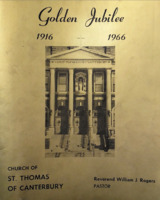 St Thomas 50th Year Anniversary
St Thomas 50th Year Anniversary This pamphlet is in celebration of St Thomas' 50th year since them being open. The phrase "Golden Jubilee" marks a 50th anniversary. It variously is applied to people, events, and nations. During this time, the main pastor at the Church was Father William Rogers. Father William Rogers served as the main pastor whose leadership and vision transformed St. Thomas Church into a beacon of diversity and openness. Cited and credited for his pivotal role, Father Rogers' commitment to inclusivity and acceptance has shaped the church's identity profoundly. Under his guidance, St. Thomas has become a sanctuary where all are welcomed with open arms.
-
 St Thomas Elementary School Image
St Thomas Elementary School Image St Thomas established the school in 1916, the Parish School was opened with an enrollment of 60 children, kindergarten through fourth grade, by the Sisters of Charity of the Blessed Virgin Mary. This photo is the photo of the first class of St Thomas, back in 1916 when the school was first established. The school itself today has a wide range of ethnic groups representing the city of Uptown,the largest groups being from Ghana, Nigeria, Ethiopia, and Vietnam. To this day, the school still offers teachings in both English and Spanish, and the Spanish-speaking population in the Uptown area is relatively high. A large part of the reason why the school was established was to create a sense of fuller community within the Church. During this period, Churches were established as a “third location”, where people could not only go to worship, but it was part of their social lives. People would send their kids to the school and they would meet their friends at the Church: St Thomas could embody every part of a community.
-
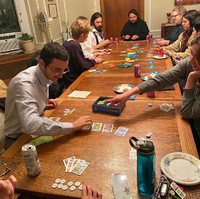 St. Ita's Game Night
St. Ita's Game Night To keep a sense of community throughout the three parishes, Mary, Mother of God Parish creates different and fun events to engage with their parishioners. In this picture, parishioners are having a fun evening playing Monopoly and card games at St. Ita's rectory. This event was mainly targeted at the young adults of the parishes. Members from each parish were more than welcomed to join and enjoy their evening playing fun games.
-
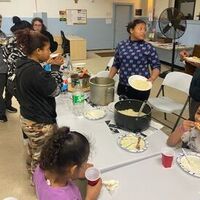 Canterbury House Dinner (2/2)
Canterbury House Dinner (2/2) Canterbury House, a parish ministry created in the wake of the MMOG merger, is hosted in St. Thomas of Canterbury Church and serves as a mutual aid organization modeled after the Catholic Worker movement. Canterbury House Director James Murphy with help from parishioners has been holding a homecooked weekly Wednesday dinner for migrants, many of whom are staying in local shelters. This current project emphasizes the need to accept and care for those in need, particularly migrants.
-
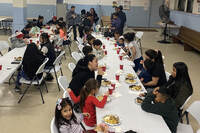 Canterbury House Dinner (1/2)
Canterbury House Dinner (1/2) Canterbury House, a parish ministry created in the wake of the MMOG merger, is hosted in St. Thomas of Canterbury Church and serves as a mutual aid organization modeled after the Catholic Worker movement. Canterbury House Director James Murphy with help from parishioners has been holding a homecooked weekly Wednesday dinner for migrants, many of whom are staying in local shelters. This current project emphasizes the need to accept and care for those in need, particularly migrants.
-
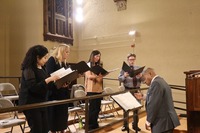 Choral Mass at St. Gregory Church
Choral Mass at St. Gregory Church Demonstrating St. Gregory's longstanding role in celebrating the role of sacred art, music, and culture in Catholic veneration, this annunciation choral mass photographed April 8, 2024 exists among countless other unique performances held at St. Gregory's Hall.
-
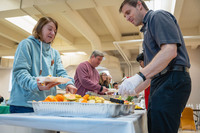 St. Ita's Pancake Breakfast (2/2)
St. Ita's Pancake Breakfast (2/2) St. Ita's church hosts many events on the behalf of Mary, Mother of God for both parishioners and non parishioners alike; one of their more popular events is their Pancake breakfast. Parishioners are invited to gather after Sunday mass and eat breakfast with one another. This event was hosted in March of 2024 by the Knights of Columbus, a charitable Catholic fraternal organization. The breakfast serves as a way to keep the parish community alive and united, as well as to get Parishioners who perhaps may come from one of the two other parishes to get to know each other. The breakfast also serves to further St. Ita's longstanding tradition as a fund raising center for its community, and now for the whole Mary, Mother of God parish.
-
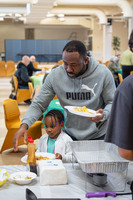 St. Ita's Pancake Breakfast (1/2)
St. Ita's Pancake Breakfast (1/2) St. Ita's church hosts many events on the behalf of Mary, Mother of God for both parishioners and non parishioners alike; one of their more popular events is their Pancake breakfast. Parishioners are invited to gather after Sunday mass and eat breakfast with one another. This event was hosted in March of 2024 by the Knights of Columbus, a charitable Catholic fraternal organization. The breakfast serves as a way to keep the parish community alive and united, as well as to get Parishioners who perhaps may come from one of the two other parishes to get to know each other. The breakfast also serves to further St. Ita's longstanding tradition as a fund raising center for its community, and now for the whole Mary, Mother of God parish.
-
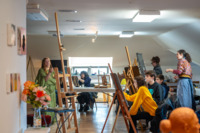 St. Gregory's Arts and Cultural Center
St. Gregory's Arts and Cultural Center Pictured is a session at St. Gregory's Hall Parish Arts and Cultural Center. This is a center that promotes Catholic culture and social teaching through art and music. Anyone is welcomed and encouraged to join. It provides a place for Parishioners to unwind and practice their Catholic culture through music and art.
-
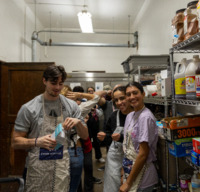 St. Thomas Soup Kitchen and Food Pantry
St. Thomas Soup Kitchen and Food Pantry In this picture, volunteers are pictured at St Thomas of Canterbury's soup kitchen and food pantry, located at 4827 N Kenmore Ave, Chicago, Il. Warm meals are served to guests every Tuesday and Friday evening. St Thomas of Canterbury's soup kitchen is always looking for volunteers and can contact Jennifer through the Mary, Mother of God website.
-
 St. Thomas Soup Kitchen
St. Thomas Soup Kitchen In this picture, volunteers are pictured at St Thomas of Canterbury's soup kitchen and food pantry, located at 4827 N Kenmore Ave, Chicago, Il. Warm meals are served to guests every Tuesday and Friday evening. St Thomas of Canterbury's soup kitchen is always looking for volunteers and can contact Jennifer through the Mary, Mother of God website.
-
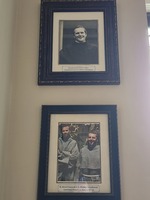 Two photographs at St Thomas of Canterbury
Two photographs at St Thomas of Canterbury This photograph is of a wall in St. Thomas of Canterbury church, a display of two framed photographs. The top one is a black and white photograph of a smiling man wearing the black robe customary of a Franciscan Friar. A small typed label under it reads "Servant of God Casimir Cypher, Conventional Franciscan Martyr of Honduras". The frame surrounding this photograph is black with some white painted decoration around the edges. The bottom photograph is approximately the same size, also in a black frame. This one is in color and depicts the top half of two smiling men in similar uniforms to the above. They are standing in a bright, sunny place in front of some faded green foliage. The caption underneath this photograph reads "Bl. Michal Tomaszek & Bl. Zbigniew Strzalkowski, Conventional Franciscan Martyrs of Peru".
-
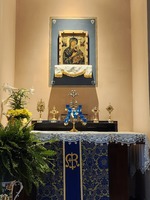 Orthodox-style Icon of Mary and Jesus
Orthodox-style Icon of Mary and Jesus This photograph is of a display at St. Thomas of Canterbury. There is a table with a blue and gold tablecloth and on top of it five gold crosses in a row. In front of the middle one is a display of several small blue glass cups, all of which are empty. The left side of the table is obscured by an offscreen plant display. Above the table is a painting of Mary and baby Jesus in a distinctly Orthodox style. Mary and Jesus are both wearing crowns and flanked by small angels on either side. Next to Jesus is the letters "IC XC", a Greek notation for Jesus Christ. Next to Mary is the letters "MP OY", a Greek notation for Mother of God. This artwork is inlaid in a wooden frame and mounted on a shelf protruding from the wall, which is covered in a small white fabric with gold edges. Surrounding the whole thing is a large blue painted square, with small painted shields on each corner.
-
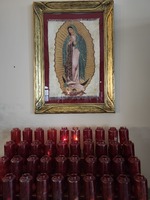 Icon of Mary with candles
Icon of Mary with candles This is a photograph taken of a display in St. Thomas of Canterbury. There is an artwork of Mary and Jesus in a frame and underneath it an array of electric candles for people to 'light', of which some are on. The artwork is a piece of textile art in a Latin American style. In it, Mary is wearing a blue shawl with gold stars on it over a pink robe. She is praying and her eyes are closed. Underneath Mary is baby Jesus, wearing magenta. His arms are outstretched and he has a joyful expression. Only the top half of him is visible because the artwork is cut off by a few inches of fringe or unraveling thread on the top and bottom. Surrounding both Mary and Jesus is a two-toned gold halo, and behind them is a white background of the fabric on which the artwork was made.
-
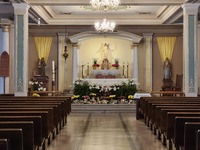 Interiors of St. Thomas of Canterbury
Interiors of St. Thomas of Canterbury These are two pictures of the interior of St. Thomas of Canterbury. The first is a picture of the altar decorated for Easter, with plants like Easter lilies spread out around it. The altar is empty with a white tablecloth on it with gold decorations. Behind it is a gold pyx, or communion box, flanked on either side with a little flower arrangement. Behind the pyx is a statue of Jesus on a pedestal, holding a cross draped with a white fabric. Encircling the altars is several white and gold pillars, holding up an arch partially obscured by a lit chandelier. On the white arch is the sentence "Sanctus Sanctus Sanctus" in gold with decorative crosses on either side. The second picture shows the pews, which are dark brown wood, and part of the ceiling, which is made up of several large square tiles held up by blue, white, and gold pillars. Some of the ceiling tiles have fans or chandeliers hanging from them.
-
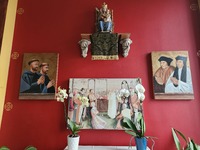 Religious Icons in St. Thomas of Canterbury
Religious Icons in St. Thomas of Canterbury This is a set of 3 images of a wall in St Thomas of Canterbury and the artworks on it. The first is the wall in full, with four distinct artworks. On top is a statue of Mary and baby Jesus, both sitting on a throne and wearing crowns. Jesus is also holding a bible and Mary is holding a flower. Below that statue to the left and right are paintings of saints praying. They are each labeled in their Latin names. On the left is "Sanct Ioann Wall" (Saint John Wall) and "Sanct Ioann Iones" (Saint John Jones). On the right is "Sanct Thom More" (Saint Thomas More) and "Sanct Ioann Fisher" (Saint John Fisher). These two artworks are shown in detail in the second and third images. Beneath both of them in the middle is a painting of a religious service with several people in prayer and priests. In front of that painting is two white orchids.
-
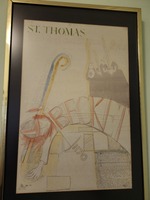 St. Thomas Beckett
St. Thomas Beckett This is a picture of a colored pencil drawing taken from a room in the rectory of St. Thomas of Canterbury. In it, St. Thomas is laying on the ground with a broken and bloodstained sword on his neck, representing his martyrdom. Instead of a body is a stylized version of the name Beckett in all red, which is another name for this saint. To the top left of him is the name St. Thomas and to the top right is a crowd of people with weapons. In the bottom right is a short bit of notation, reading "61/72, JAZ, 70". Around St. Thomas in faint text is a quote near his head with blood spilling onto it. It reads "I give my life to the law of God above the law of man those who do not the same how should they know what I do? How should you know what I do?" and an attribution to T.S. Eliot's "Murder in the Cathedral"
-
 Martyrdom of St. Thomas of Canterbury
Martyrdom of St. Thomas of Canterbury This is an image in St. Thomas of Canterbury depicting the namesake saint's murder. In it, St. Thomas is praying with the top of his head cut off by the threatening soldiers around him, and his mitre and part of his head is bleeding out on the ground. Above the artwork is a plaque reading "Martyrdom of St. Thomas of Canterbury, In Memory of Delia Pluemer, Dedicated November 29, 2009"
-
 Interview-Deacan Paul
Interview-Deacan Paul interview with deacan Paul about church culture. history, and life with Deacan Paul of St. Gregory the Great,
-
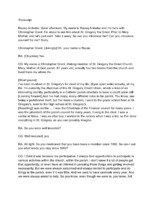 Life as a lifelong parishioner and credit union chairman
Life as a lifelong parishioner and credit union chairman Lifelong parishioner and credit union chairman, Christopher Grant provides insight into the credit union and lif as a member since the 60s.
-
 Oral History of Fr. Alejandro
Oral History of Fr. Alejandro Discussion on the impact of the merger, the conventual Franciscans, his own personal struggles, and how the church has grown as a result of the merger; "one of the challenges as a priest is learning how to say, I can't do that right now, or I can't do that period. That must be hard. It is hard because as a priest you also want to help. And you've got the good shepherd as your role model and he's saying go out to the lost sheep and bring them in. Go out to those in need. The ones that are most in need are the ones often that get left behind because you've got other things that are calling you and your attention and it's not easy. So sometimes you feel spread a little thin
-
 Stephanie Held Oral History
Stephanie Held Oral History In this oral history, I decided to interview Stephanie Held, church coordinator at Mary, Mother of God Parish. In this interview, Stephanie discussed the future of the three parishes as one, the reactions to the merging of the parishes, and much more. Stephanie was a great candidate for our Remember My Church project due to her closeness to not only the parishes but also to the parishioners. Stephanie herself attends all three parishes and therefore has her own opinions on this topic. She believes the Mary, Mother of God parish has a bright, positive future and gives us insight into parish events.
 Saint Ita Interview with Ed Stranc In this interview with Saint Ita parishioner, Ed Stranc, we discuss all things Saint Ita. Specifically, we discussed his time at the church, his involvement with the parish, his thoughts about Mary, Mother of God, and the role of social media and religion in today's society.
Saint Ita Interview with Ed Stranc In this interview with Saint Ita parishioner, Ed Stranc, we discuss all things Saint Ita. Specifically, we discussed his time at the church, his involvement with the parish, his thoughts about Mary, Mother of God, and the role of social media and religion in today's society. Dennis Donelon Interview This is an oral history interview with Dennis Donelon, who has been volunteering with the soup kitchen for over 20 years. The interviewer is Kasey Ohn, with Roman Rosari, Charles Bevenour, and Kylie Miller offering questions as well. Dennis discusses his history with the soup kitchen: he goes into his son's passing and mental health struggles which motivated him to volunteer at a soup kitchen to honor his memory. He also discusses the soup kitchen and it's history, as well as what sets it apart from others in the area, as well as offering advice on what he has taken away from the years with the Church.
Dennis Donelon Interview This is an oral history interview with Dennis Donelon, who has been volunteering with the soup kitchen for over 20 years. The interviewer is Kasey Ohn, with Roman Rosari, Charles Bevenour, and Kylie Miller offering questions as well. Dennis discusses his history with the soup kitchen: he goes into his son's passing and mental health struggles which motivated him to volunteer at a soup kitchen to honor his memory. He also discusses the soup kitchen and it's history, as well as what sets it apart from others in the area, as well as offering advice on what he has taken away from the years with the Church. St Thomas 50th Year Anniversary This pamphlet is in celebration of St Thomas' 50th year since them being open. The phrase "Golden Jubilee" marks a 50th anniversary. It variously is applied to people, events, and nations. During this time, the main pastor at the Church was Father William Rogers. Father William Rogers served as the main pastor whose leadership and vision transformed St. Thomas Church into a beacon of diversity and openness. Cited and credited for his pivotal role, Father Rogers' commitment to inclusivity and acceptance has shaped the church's identity profoundly. Under his guidance, St. Thomas has become a sanctuary where all are welcomed with open arms.
St Thomas 50th Year Anniversary This pamphlet is in celebration of St Thomas' 50th year since them being open. The phrase "Golden Jubilee" marks a 50th anniversary. It variously is applied to people, events, and nations. During this time, the main pastor at the Church was Father William Rogers. Father William Rogers served as the main pastor whose leadership and vision transformed St. Thomas Church into a beacon of diversity and openness. Cited and credited for his pivotal role, Father Rogers' commitment to inclusivity and acceptance has shaped the church's identity profoundly. Under his guidance, St. Thomas has become a sanctuary where all are welcomed with open arms. St Thomas Elementary School Image St Thomas established the school in 1916, the Parish School was opened with an enrollment of 60 children, kindergarten through fourth grade, by the Sisters of Charity of the Blessed Virgin Mary. This photo is the photo of the first class of St Thomas, back in 1916 when the school was first established. The school itself today has a wide range of ethnic groups representing the city of Uptown,the largest groups being from Ghana, Nigeria, Ethiopia, and Vietnam. To this day, the school still offers teachings in both English and Spanish, and the Spanish-speaking population in the Uptown area is relatively high. A large part of the reason why the school was established was to create a sense of fuller community within the Church. During this period, Churches were established as a “third location”, where people could not only go to worship, but it was part of their social lives. People would send their kids to the school and they would meet their friends at the Church: St Thomas could embody every part of a community.
St Thomas Elementary School Image St Thomas established the school in 1916, the Parish School was opened with an enrollment of 60 children, kindergarten through fourth grade, by the Sisters of Charity of the Blessed Virgin Mary. This photo is the photo of the first class of St Thomas, back in 1916 when the school was first established. The school itself today has a wide range of ethnic groups representing the city of Uptown,the largest groups being from Ghana, Nigeria, Ethiopia, and Vietnam. To this day, the school still offers teachings in both English and Spanish, and the Spanish-speaking population in the Uptown area is relatively high. A large part of the reason why the school was established was to create a sense of fuller community within the Church. During this period, Churches were established as a “third location”, where people could not only go to worship, but it was part of their social lives. People would send their kids to the school and they would meet their friends at the Church: St Thomas could embody every part of a community. St. Ita's Game Night To keep a sense of community throughout the three parishes, Mary, Mother of God Parish creates different and fun events to engage with their parishioners. In this picture, parishioners are having a fun evening playing Monopoly and card games at St. Ita's rectory. This event was mainly targeted at the young adults of the parishes. Members from each parish were more than welcomed to join and enjoy their evening playing fun games.
St. Ita's Game Night To keep a sense of community throughout the three parishes, Mary, Mother of God Parish creates different and fun events to engage with their parishioners. In this picture, parishioners are having a fun evening playing Monopoly and card games at St. Ita's rectory. This event was mainly targeted at the young adults of the parishes. Members from each parish were more than welcomed to join and enjoy their evening playing fun games. Canterbury House Dinner (2/2) Canterbury House, a parish ministry created in the wake of the MMOG merger, is hosted in St. Thomas of Canterbury Church and serves as a mutual aid organization modeled after the Catholic Worker movement. Canterbury House Director James Murphy with help from parishioners has been holding a homecooked weekly Wednesday dinner for migrants, many of whom are staying in local shelters. This current project emphasizes the need to accept and care for those in need, particularly migrants.
Canterbury House Dinner (2/2) Canterbury House, a parish ministry created in the wake of the MMOG merger, is hosted in St. Thomas of Canterbury Church and serves as a mutual aid organization modeled after the Catholic Worker movement. Canterbury House Director James Murphy with help from parishioners has been holding a homecooked weekly Wednesday dinner for migrants, many of whom are staying in local shelters. This current project emphasizes the need to accept and care for those in need, particularly migrants. Canterbury House Dinner (1/2) Canterbury House, a parish ministry created in the wake of the MMOG merger, is hosted in St. Thomas of Canterbury Church and serves as a mutual aid organization modeled after the Catholic Worker movement. Canterbury House Director James Murphy with help from parishioners has been holding a homecooked weekly Wednesday dinner for migrants, many of whom are staying in local shelters. This current project emphasizes the need to accept and care for those in need, particularly migrants.
Canterbury House Dinner (1/2) Canterbury House, a parish ministry created in the wake of the MMOG merger, is hosted in St. Thomas of Canterbury Church and serves as a mutual aid organization modeled after the Catholic Worker movement. Canterbury House Director James Murphy with help from parishioners has been holding a homecooked weekly Wednesday dinner for migrants, many of whom are staying in local shelters. This current project emphasizes the need to accept and care for those in need, particularly migrants. Choral Mass at St. Gregory Church Demonstrating St. Gregory's longstanding role in celebrating the role of sacred art, music, and culture in Catholic veneration, this annunciation choral mass photographed April 8, 2024 exists among countless other unique performances held at St. Gregory's Hall.
Choral Mass at St. Gregory Church Demonstrating St. Gregory's longstanding role in celebrating the role of sacred art, music, and culture in Catholic veneration, this annunciation choral mass photographed April 8, 2024 exists among countless other unique performances held at St. Gregory's Hall. St. Ita's Pancake Breakfast (2/2) St. Ita's church hosts many events on the behalf of Mary, Mother of God for both parishioners and non parishioners alike; one of their more popular events is their Pancake breakfast. Parishioners are invited to gather after Sunday mass and eat breakfast with one another. This event was hosted in March of 2024 by the Knights of Columbus, a charitable Catholic fraternal organization. The breakfast serves as a way to keep the parish community alive and united, as well as to get Parishioners who perhaps may come from one of the two other parishes to get to know each other. The breakfast also serves to further St. Ita's longstanding tradition as a fund raising center for its community, and now for the whole Mary, Mother of God parish.
St. Ita's Pancake Breakfast (2/2) St. Ita's church hosts many events on the behalf of Mary, Mother of God for both parishioners and non parishioners alike; one of their more popular events is their Pancake breakfast. Parishioners are invited to gather after Sunday mass and eat breakfast with one another. This event was hosted in March of 2024 by the Knights of Columbus, a charitable Catholic fraternal organization. The breakfast serves as a way to keep the parish community alive and united, as well as to get Parishioners who perhaps may come from one of the two other parishes to get to know each other. The breakfast also serves to further St. Ita's longstanding tradition as a fund raising center for its community, and now for the whole Mary, Mother of God parish. St. Ita's Pancake Breakfast (1/2) St. Ita's church hosts many events on the behalf of Mary, Mother of God for both parishioners and non parishioners alike; one of their more popular events is their Pancake breakfast. Parishioners are invited to gather after Sunday mass and eat breakfast with one another. This event was hosted in March of 2024 by the Knights of Columbus, a charitable Catholic fraternal organization. The breakfast serves as a way to keep the parish community alive and united, as well as to get Parishioners who perhaps may come from one of the two other parishes to get to know each other. The breakfast also serves to further St. Ita's longstanding tradition as a fund raising center for its community, and now for the whole Mary, Mother of God parish.
St. Ita's Pancake Breakfast (1/2) St. Ita's church hosts many events on the behalf of Mary, Mother of God for both parishioners and non parishioners alike; one of their more popular events is their Pancake breakfast. Parishioners are invited to gather after Sunday mass and eat breakfast with one another. This event was hosted in March of 2024 by the Knights of Columbus, a charitable Catholic fraternal organization. The breakfast serves as a way to keep the parish community alive and united, as well as to get Parishioners who perhaps may come from one of the two other parishes to get to know each other. The breakfast also serves to further St. Ita's longstanding tradition as a fund raising center for its community, and now for the whole Mary, Mother of God parish. St. Gregory's Arts and Cultural Center Pictured is a session at St. Gregory's Hall Parish Arts and Cultural Center. This is a center that promotes Catholic culture and social teaching through art and music. Anyone is welcomed and encouraged to join. It provides a place for Parishioners to unwind and practice their Catholic culture through music and art.
St. Gregory's Arts and Cultural Center Pictured is a session at St. Gregory's Hall Parish Arts and Cultural Center. This is a center that promotes Catholic culture and social teaching through art and music. Anyone is welcomed and encouraged to join. It provides a place for Parishioners to unwind and practice their Catholic culture through music and art. St. Thomas Soup Kitchen and Food Pantry In this picture, volunteers are pictured at St Thomas of Canterbury's soup kitchen and food pantry, located at 4827 N Kenmore Ave, Chicago, Il. Warm meals are served to guests every Tuesday and Friday evening. St Thomas of Canterbury's soup kitchen is always looking for volunteers and can contact Jennifer through the Mary, Mother of God website.
St. Thomas Soup Kitchen and Food Pantry In this picture, volunteers are pictured at St Thomas of Canterbury's soup kitchen and food pantry, located at 4827 N Kenmore Ave, Chicago, Il. Warm meals are served to guests every Tuesday and Friday evening. St Thomas of Canterbury's soup kitchen is always looking for volunteers and can contact Jennifer through the Mary, Mother of God website. St. Thomas Soup Kitchen In this picture, volunteers are pictured at St Thomas of Canterbury's soup kitchen and food pantry, located at 4827 N Kenmore Ave, Chicago, Il. Warm meals are served to guests every Tuesday and Friday evening. St Thomas of Canterbury's soup kitchen is always looking for volunteers and can contact Jennifer through the Mary, Mother of God website.
St. Thomas Soup Kitchen In this picture, volunteers are pictured at St Thomas of Canterbury's soup kitchen and food pantry, located at 4827 N Kenmore Ave, Chicago, Il. Warm meals are served to guests every Tuesday and Friday evening. St Thomas of Canterbury's soup kitchen is always looking for volunteers and can contact Jennifer through the Mary, Mother of God website. Two photographs at St Thomas of Canterbury This photograph is of a wall in St. Thomas of Canterbury church, a display of two framed photographs. The top one is a black and white photograph of a smiling man wearing the black robe customary of a Franciscan Friar. A small typed label under it reads "Servant of God Casimir Cypher, Conventional Franciscan Martyr of Honduras". The frame surrounding this photograph is black with some white painted decoration around the edges. The bottom photograph is approximately the same size, also in a black frame. This one is in color and depicts the top half of two smiling men in similar uniforms to the above. They are standing in a bright, sunny place in front of some faded green foliage. The caption underneath this photograph reads "Bl. Michal Tomaszek & Bl. Zbigniew Strzalkowski, Conventional Franciscan Martyrs of Peru".
Two photographs at St Thomas of Canterbury This photograph is of a wall in St. Thomas of Canterbury church, a display of two framed photographs. The top one is a black and white photograph of a smiling man wearing the black robe customary of a Franciscan Friar. A small typed label under it reads "Servant of God Casimir Cypher, Conventional Franciscan Martyr of Honduras". The frame surrounding this photograph is black with some white painted decoration around the edges. The bottom photograph is approximately the same size, also in a black frame. This one is in color and depicts the top half of two smiling men in similar uniforms to the above. They are standing in a bright, sunny place in front of some faded green foliage. The caption underneath this photograph reads "Bl. Michal Tomaszek & Bl. Zbigniew Strzalkowski, Conventional Franciscan Martyrs of Peru". Orthodox-style Icon of Mary and Jesus This photograph is of a display at St. Thomas of Canterbury. There is a table with a blue and gold tablecloth and on top of it five gold crosses in a row. In front of the middle one is a display of several small blue glass cups, all of which are empty. The left side of the table is obscured by an offscreen plant display. Above the table is a painting of Mary and baby Jesus in a distinctly Orthodox style. Mary and Jesus are both wearing crowns and flanked by small angels on either side. Next to Jesus is the letters "IC XC", a Greek notation for Jesus Christ. Next to Mary is the letters "MP OY", a Greek notation for Mother of God. This artwork is inlaid in a wooden frame and mounted on a shelf protruding from the wall, which is covered in a small white fabric with gold edges. Surrounding the whole thing is a large blue painted square, with small painted shields on each corner.
Orthodox-style Icon of Mary and Jesus This photograph is of a display at St. Thomas of Canterbury. There is a table with a blue and gold tablecloth and on top of it five gold crosses in a row. In front of the middle one is a display of several small blue glass cups, all of which are empty. The left side of the table is obscured by an offscreen plant display. Above the table is a painting of Mary and baby Jesus in a distinctly Orthodox style. Mary and Jesus are both wearing crowns and flanked by small angels on either side. Next to Jesus is the letters "IC XC", a Greek notation for Jesus Christ. Next to Mary is the letters "MP OY", a Greek notation for Mother of God. This artwork is inlaid in a wooden frame and mounted on a shelf protruding from the wall, which is covered in a small white fabric with gold edges. Surrounding the whole thing is a large blue painted square, with small painted shields on each corner. Icon of Mary with candles This is a photograph taken of a display in St. Thomas of Canterbury. There is an artwork of Mary and Jesus in a frame and underneath it an array of electric candles for people to 'light', of which some are on. The artwork is a piece of textile art in a Latin American style. In it, Mary is wearing a blue shawl with gold stars on it over a pink robe. She is praying and her eyes are closed. Underneath Mary is baby Jesus, wearing magenta. His arms are outstretched and he has a joyful expression. Only the top half of him is visible because the artwork is cut off by a few inches of fringe or unraveling thread on the top and bottom. Surrounding both Mary and Jesus is a two-toned gold halo, and behind them is a white background of the fabric on which the artwork was made.
Icon of Mary with candles This is a photograph taken of a display in St. Thomas of Canterbury. There is an artwork of Mary and Jesus in a frame and underneath it an array of electric candles for people to 'light', of which some are on. The artwork is a piece of textile art in a Latin American style. In it, Mary is wearing a blue shawl with gold stars on it over a pink robe. She is praying and her eyes are closed. Underneath Mary is baby Jesus, wearing magenta. His arms are outstretched and he has a joyful expression. Only the top half of him is visible because the artwork is cut off by a few inches of fringe or unraveling thread on the top and bottom. Surrounding both Mary and Jesus is a two-toned gold halo, and behind them is a white background of the fabric on which the artwork was made. Interiors of St. Thomas of Canterbury These are two pictures of the interior of St. Thomas of Canterbury. The first is a picture of the altar decorated for Easter, with plants like Easter lilies spread out around it. The altar is empty with a white tablecloth on it with gold decorations. Behind it is a gold pyx, or communion box, flanked on either side with a little flower arrangement. Behind the pyx is a statue of Jesus on a pedestal, holding a cross draped with a white fabric. Encircling the altars is several white and gold pillars, holding up an arch partially obscured by a lit chandelier. On the white arch is the sentence "Sanctus Sanctus Sanctus" in gold with decorative crosses on either side. The second picture shows the pews, which are dark brown wood, and part of the ceiling, which is made up of several large square tiles held up by blue, white, and gold pillars. Some of the ceiling tiles have fans or chandeliers hanging from them.
Interiors of St. Thomas of Canterbury These are two pictures of the interior of St. Thomas of Canterbury. The first is a picture of the altar decorated for Easter, with plants like Easter lilies spread out around it. The altar is empty with a white tablecloth on it with gold decorations. Behind it is a gold pyx, or communion box, flanked on either side with a little flower arrangement. Behind the pyx is a statue of Jesus on a pedestal, holding a cross draped with a white fabric. Encircling the altars is several white and gold pillars, holding up an arch partially obscured by a lit chandelier. On the white arch is the sentence "Sanctus Sanctus Sanctus" in gold with decorative crosses on either side. The second picture shows the pews, which are dark brown wood, and part of the ceiling, which is made up of several large square tiles held up by blue, white, and gold pillars. Some of the ceiling tiles have fans or chandeliers hanging from them. Religious Icons in St. Thomas of Canterbury This is a set of 3 images of a wall in St Thomas of Canterbury and the artworks on it. The first is the wall in full, with four distinct artworks. On top is a statue of Mary and baby Jesus, both sitting on a throne and wearing crowns. Jesus is also holding a bible and Mary is holding a flower. Below that statue to the left and right are paintings of saints praying. They are each labeled in their Latin names. On the left is "Sanct Ioann Wall" (Saint John Wall) and "Sanct Ioann Iones" (Saint John Jones). On the right is "Sanct Thom More" (Saint Thomas More) and "Sanct Ioann Fisher" (Saint John Fisher). These two artworks are shown in detail in the second and third images. Beneath both of them in the middle is a painting of a religious service with several people in prayer and priests. In front of that painting is two white orchids.
Religious Icons in St. Thomas of Canterbury This is a set of 3 images of a wall in St Thomas of Canterbury and the artworks on it. The first is the wall in full, with four distinct artworks. On top is a statue of Mary and baby Jesus, both sitting on a throne and wearing crowns. Jesus is also holding a bible and Mary is holding a flower. Below that statue to the left and right are paintings of saints praying. They are each labeled in their Latin names. On the left is "Sanct Ioann Wall" (Saint John Wall) and "Sanct Ioann Iones" (Saint John Jones). On the right is "Sanct Thom More" (Saint Thomas More) and "Sanct Ioann Fisher" (Saint John Fisher). These two artworks are shown in detail in the second and third images. Beneath both of them in the middle is a painting of a religious service with several people in prayer and priests. In front of that painting is two white orchids. St. Thomas Beckett This is a picture of a colored pencil drawing taken from a room in the rectory of St. Thomas of Canterbury. In it, St. Thomas is laying on the ground with a broken and bloodstained sword on his neck, representing his martyrdom. Instead of a body is a stylized version of the name Beckett in all red, which is another name for this saint. To the top left of him is the name St. Thomas and to the top right is a crowd of people with weapons. In the bottom right is a short bit of notation, reading "61/72, JAZ, 70". Around St. Thomas in faint text is a quote near his head with blood spilling onto it. It reads "I give my life to the law of God above the law of man those who do not the same how should they know what I do? How should you know what I do?" and an attribution to T.S. Eliot's "Murder in the Cathedral"
St. Thomas Beckett This is a picture of a colored pencil drawing taken from a room in the rectory of St. Thomas of Canterbury. In it, St. Thomas is laying on the ground with a broken and bloodstained sword on his neck, representing his martyrdom. Instead of a body is a stylized version of the name Beckett in all red, which is another name for this saint. To the top left of him is the name St. Thomas and to the top right is a crowd of people with weapons. In the bottom right is a short bit of notation, reading "61/72, JAZ, 70". Around St. Thomas in faint text is a quote near his head with blood spilling onto it. It reads "I give my life to the law of God above the law of man those who do not the same how should they know what I do? How should you know what I do?" and an attribution to T.S. Eliot's "Murder in the Cathedral" Martyrdom of St. Thomas of Canterbury This is an image in St. Thomas of Canterbury depicting the namesake saint's murder. In it, St. Thomas is praying with the top of his head cut off by the threatening soldiers around him, and his mitre and part of his head is bleeding out on the ground. Above the artwork is a plaque reading "Martyrdom of St. Thomas of Canterbury, In Memory of Delia Pluemer, Dedicated November 29, 2009"
Martyrdom of St. Thomas of Canterbury This is an image in St. Thomas of Canterbury depicting the namesake saint's murder. In it, St. Thomas is praying with the top of his head cut off by the threatening soldiers around him, and his mitre and part of his head is bleeding out on the ground. Above the artwork is a plaque reading "Martyrdom of St. Thomas of Canterbury, In Memory of Delia Pluemer, Dedicated November 29, 2009" Interview-Deacan Paul interview with deacan Paul about church culture. history, and life with Deacan Paul of St. Gregory the Great,
Interview-Deacan Paul interview with deacan Paul about church culture. history, and life with Deacan Paul of St. Gregory the Great, Life as a lifelong parishioner and credit union chairman Lifelong parishioner and credit union chairman, Christopher Grant provides insight into the credit union and lif as a member since the 60s.
Life as a lifelong parishioner and credit union chairman Lifelong parishioner and credit union chairman, Christopher Grant provides insight into the credit union and lif as a member since the 60s. Oral History of Fr. Alejandro Discussion on the impact of the merger, the conventual Franciscans, his own personal struggles, and how the church has grown as a result of the merger; "one of the challenges as a priest is learning how to say, I can't do that right now, or I can't do that period. That must be hard. It is hard because as a priest you also want to help. And you've got the good shepherd as your role model and he's saying go out to the lost sheep and bring them in. Go out to those in need. The ones that are most in need are the ones often that get left behind because you've got other things that are calling you and your attention and it's not easy. So sometimes you feel spread a little thin
Oral History of Fr. Alejandro Discussion on the impact of the merger, the conventual Franciscans, his own personal struggles, and how the church has grown as a result of the merger; "one of the challenges as a priest is learning how to say, I can't do that right now, or I can't do that period. That must be hard. It is hard because as a priest you also want to help. And you've got the good shepherd as your role model and he's saying go out to the lost sheep and bring them in. Go out to those in need. The ones that are most in need are the ones often that get left behind because you've got other things that are calling you and your attention and it's not easy. So sometimes you feel spread a little thin Stephanie Held Oral History In this oral history, I decided to interview Stephanie Held, church coordinator at Mary, Mother of God Parish. In this interview, Stephanie discussed the future of the three parishes as one, the reactions to the merging of the parishes, and much more. Stephanie was a great candidate for our Remember My Church project due to her closeness to not only the parishes but also to the parishioners. Stephanie herself attends all three parishes and therefore has her own opinions on this topic. She believes the Mary, Mother of God parish has a bright, positive future and gives us insight into parish events.
Stephanie Held Oral History In this oral history, I decided to interview Stephanie Held, church coordinator at Mary, Mother of God Parish. In this interview, Stephanie discussed the future of the three parishes as one, the reactions to the merging of the parishes, and much more. Stephanie was a great candidate for our Remember My Church project due to her closeness to not only the parishes but also to the parishioners. Stephanie herself attends all three parishes and therefore has her own opinions on this topic. She believes the Mary, Mother of God parish has a bright, positive future and gives us insight into parish events.